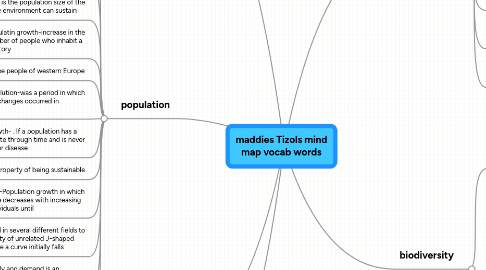maddies Tizols mind map vocab words
por madeline tizol


1. biotic/ abiotic factors
1.1. producer-manufacturer: someone who manufactures something
1.2. primary consumer-An herbivore is an animal that is adapted to eat plants
1.3. secondary consumer-A carnivore , meaning 'meat eater'
1.4. tertiary consumer-In ecology, trophic dynamics is the system of trophic levels
1.5. trophic levels-The trophic level of an organism is the position it occupies on the food chain
2. limiting factors
2.1. ecological succession-the gradual and orderly process of change in an ecosystem
2.2. primary succession-is one of two types of biological and ecological succession of plant life, occurring in an environment in which new substrate devoid
2.3. secondary succession- is one of the two types of ecological succession of plant life. As opposed to primary succession,
3. population
3.1. pioneer species-are species which colonize previously uncolonized
3.2. climax community-In ecology, a climax community, or climatic climax community, is a biological community of plants and animals
3.3. limiting factors-a factor that controls a process
3.4. carrying capacity- of a biological species in an environment is the population size of the species that the environment can sustain
3.5. populatin growth-increase in the number of people who inhabit a territory
3.6. black plague-Black Death: the epidemic form of bubonic plague experienced during the Middle Ages when it killed nearly half the people of western Europe
3.7. industrial revolution-was a period in which fundamental changes occurred in agriculture,
3.8. exponential growth- . If a population has a constant birth rate through time and is never limited by food or disease
3.9. sustainability-the property of being sustainable
3.10. logistic growth-Population growth in which the growth rate decreases with increasing number of individuals until
3.11. j-curve-is used in several different fields to refer to a variety of unrelated J-shaped diagrams where a curve initially falls
3.12. s-curve-Supply and demand is an economic model of price determination in a market
3.13. population growth raye- is the change in a population over time
4. water polution
4.1. aquifer-is a wet underground layer of water-bearing permeable rock
4.2. runoff-overflow: the occurrence of surplus liquid (as water) exceeding the limit or capacity
5. food webs
5.1. organism-is any contiguous living system
5.2. population-is all the organisms that both belong to the same species and live in the same geographical area
5.3. community-organisms inhabiting a common environment and interacting with one another
5.4. ecosystem-is a biological environment consisting of all the organisms living in a particular area, as well as all the nonliving, physical components
5.5. biome-are climatically and geographically defined as similar climatic conditions on the Earth
5.6. biosphere- is the global sum of all ecosystems. It can also be called the zone of life on Earth
5.7. food chain-are representations of the predator-prey relationships between species within an ecosystem or habitat
5.8. food web- are representations of the predator-prey relationships between species within an ecosystem or habitat
6. biodiversity
6.1. biome
6.1.1. temperate deciduous forest- have four distinct seasons.
6.1.2. coniferous forest-is a terrestrial biome found in temperate regions of the world
6.1.3. desert- is a landscape or region that receives an extremely low amount of precipitation
6.1.4. tundra-is the coldest of all the biomes
6.1.5. grassland/savannah-are characterized as lands dominated by grasses rather than large shrubs or trees
6.1.6. freshwater biome-is defined as having a low salt concentration
